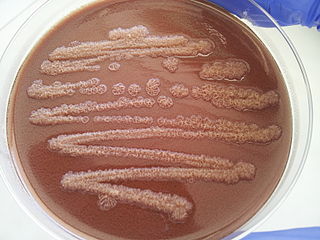
A polychlorinated biphenyl (PCB) is an organic chlorine compound with the formula C12H10−xClx. Polychlorinated biphenyls were once widely deployed as dielectric and coolant fluids in electrical apparatus, carbonless copy paper and in heat transfer fluids.

Pseudomonas stutzeri is a Gram-negative soil bacterium that is motile, has a single polar flagellum, and is classified as bacillus, or rod-shaped. While this bacterium was first isolated from human spinal fluid, it has since been found in many different environments due to its various characteristics and metabolic capabilities. P. stutzeri is an opportunistic pathogen in clinical settings, although infections are rare. Based on 16S rRNA analysis, this bacterium has been placed in the P. stutzeri group, to which it lends its name.

Yushō disease was a mass poisoning by polychlorinated biphenyls (PCBs) which occurred in northern Kyūshū, Japan, in 1968. In January 1968, rice bran oil produced by Kanemi Company in Kyushu was contaminated with PCBs and polychlorinated dibenzofurans (PCDFs) during production. For deodorization, the oil was heated using PCB as the heating medium, circulating through pipes. Due to holes in the pipes the PCB leaked into the rice bran oil. The contaminated rice bran oil was then sold to poultry farmers for use as a feed supplement and to consumers for use in cooking. In February to March 1968, farmers started reporting that their poultry were dying due to apparent difficulty in breathing; altogether 400,000 birds died. About 14,000 people who had consumed the contaminated rice oil were affected in Japan. More than 500 died. Common symptoms included dermal and ocular lesions, irregular menstrual cycles and a lowered immune response. Other symptoms included fatigue, headache, cough, and unusual skin sores. Additionally, in children, there were reports of poor cognitive development.
Novosphingobium is a genus of Gram-negative bacteria that includes N. taihuense, which can degrade aromatic compounds such as phenol, aniline, nitrobenzene and phenanthrene. The species N. aromativorans, which was first found in Ulsan Bay, similarly degrades aromatic molecules of two to five rings.

Dioxins and dioxin-like compounds (DLCs) are a group of chemical compounds that are persistent organic pollutants (POPs) in the environment. They are mostly by-products of burning or various industrial processes - or, in case of dioxin-like PCBs and PBBs, unwanted minor components of intentionally produced mixtures.
Polaromonas naphthalenivorans is a Gram-negative, oxidase- and catalase-positive, non-spore-forming, nonmotile bacterium from the genus Polaromonas, which was isolated from coal-tar contaminated freshwater sediment. P. naphthalenivorans has the ability to degrade naphthalene. Its colonies have a smooth and glistening surface.
Novosphingobium pentaromativorans is a species of high-molecular-mass polycyclic aromatic hydrocarbon-degrading bacterium. It is Gram-negative, yellow-pigmented and halophilic. With type strain US6-1T. Its genome has been sequenced.
Nocardioides aromaticivorans is a gram-positive non-motile bacterium from the genus Nocardioides thathas been isolated from a river contaminated with dioxin in Kanagawa, Japan. Nocardioides aromaticivorans has the ability to degrade dibenzofuran and carbazole.
Novosphingobium barchaimii is a bacterium from the genus Novosphingobium which has been isolated from soil which was contaminated with hexachlorocyclohexane from the Spolana Neratovice plant in the Czech Republic.
Novosphingobium chloroacetimidivorans is a Gram-negative, chloroacetamide-degrading and non-spore-forming bacterium from the genus Novosphingobium which has been isolated from activated sludge from a wastewater treatment plant in Kunshan City in China.
Novosphingobium fluoreni is a Gram-negative, fluorene-degrading, rod-shaped and non-spore-forming bacterium from the genus Novosphingobium which has been isolated rice seeds from Jiansanjiang in China.
Novosphingobium indicum is a bacterium from the genus Novosphingobium which has been isolated from deep-sea water from the Indian Ocean. Novosphingobium indicum hasd the ability to degrade polycyclic aromatic hydrocarbon.
Novosphingobium lentum is a Gram-negative, rod-shaped, non-spore-forming, psychrotolerant and non-motile bacterium from the genus Novosphingobium which has been isolated from chlorophenol-contaminated groundwater in Finland. Novosphingobium lentum has the ability to degrade chlorophenol.
Novosphingobium lindaniclasticum is a Gram-negative, aerobic, rod-shaped, non-spore-forming and non-motile bacterium from the genus Novosphingobium which has been isolated from a hexachlorocyclohexane dumpsite in Lucknow in India. Novosphingobium lindaniclasticum has the ability to degrade hexachlorocyclohexane.
Novosphingobium mathurense is a Gram-negative and halophilic bacterium from the genus Novosphingobium which has been isolated from oil-contaminated soil in Mathura in India.
Novosphingobium panipatense is a Gram-negative and halophilic bacterium from the genus Novosphingobium which has been isolated from oil-contaminated soil in Panipat in India.
Novosphingobium soli is a Gram-negative, rod-shaped and non-spore-forming bacterium from the genus Novosphingobium which has been isolated from oil-contaminated soil near an oil refinery in Kaohsiung County in Taiwan.
Novosphingobium taihuense is a bacterium from the genus Novosphingobium which has been isolated from lake sediments from the Taihu Lake in China. Novosphingobium taihuense has the ability to degrade phenol, aniline, nitrobenzene, 4-chloronitrobenzene and phenanthrene.
Caenibius tardaugens is an oestradiol-degrading bacterium from the family Sphingomonadaceae which has been isolated from activated sludge from a sewage treatment plant in Japan.
Actibacterium naphthalenivorans is a Gram-negative, aerobic, naphthalene-degrading, moderately halophilic and motile bacterium from the genus Actibacterium with a single flagellum which has been isolated from tidal flat sediments from the South Sea in Korea.



